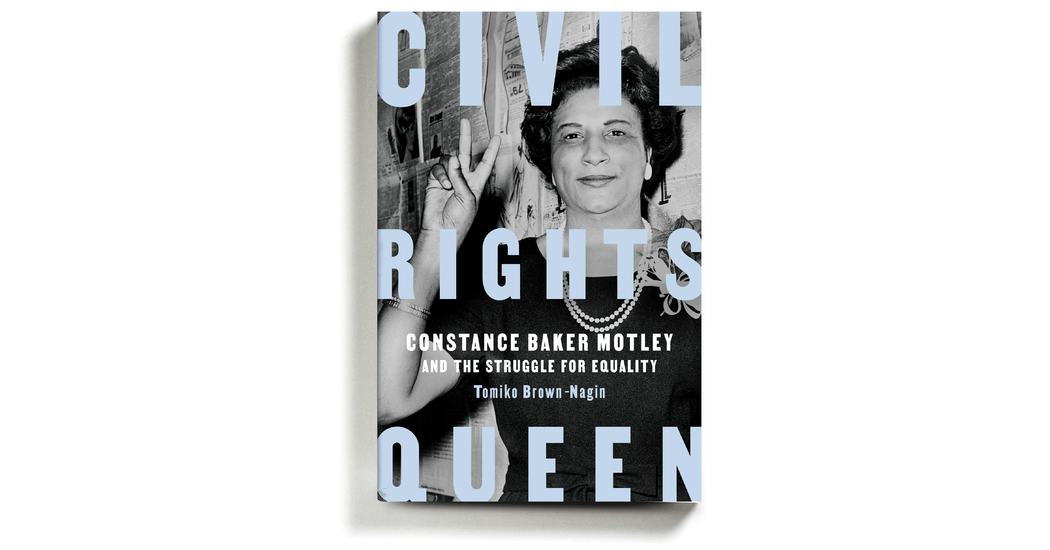
How do you measure progress? The incrementalist counsels patience: Something is better than nothing, half a loaf is better than none.
Characteristically, Malcolm X wasn’t having any of that. In a televised round table in 1961, the civil rights lawyer Constance Baker Motley tried to coax Malcolm into acknowledging that the average Black American “is substantially better off than he was at the end of slavery.” He scorned the very premise. “Now you have 20 million Black people in America who are begging for some kind of recognition as human beings,” he said, referring to the Black Americans imprisoned at the time, “and the average white man today thinks we’re making progress.”
It’s an evocative exchange, one that the Harvard legal historian Tomiko Brown-Nagin showcases to illuminating effect in “Civil Rights Queen,” the first major biography of Motley, a decade in the making. Brown-Nagin juxtaposes Motley’s attempts to find common ground by asking a series of lawyerly questions (“You recognize, don’t you …? “Don’t you think …?”) with Malcolm’s scathing rejoinders. By the mid-1960s, Motley had been caught “in a bind,” Brown-Nagin writes. Working at the NAACP Legal Defense and Educational Fund Inc., or Inc Fund, since 1946, she had been a crucial figure in using the courts to dismantle Jim Crow laws. Motley had helped litigate Brown v. Board of Education; she fought for Martin Luther King Jr.’s right to march in Birmingham. But to radicals disenchanted with the mainstream civil rights movement, she was “weak and accommodationist,” Brown-Nagin writes. Set against figures like Malcolm, “her politics and style looked tamer — and they were.”
Not that Motley was necessarily accepted wholeheartedly into the hallways of American power either. As Brown-Nagin shows in this thoughtful biography, Motley was lambasted by one side as “a pawn of the white establishment,” but she was sometimes criticized by elements of that white establishment for not being moderate enough.
In 1966, President Lyndon B. Johnson appointed her to the Southern District of New York, making her the first Black woman to serve as a federal judge. She constantly faced doubts among those who presumed that her identity would make her biased. During her confirmation hearings, she was accused of being a Communist — which was ironic, considering that as a judge Motley would regularly enforce the property rights of business owners. “In her courtroom,” Brown-Nagin writes, “no less than in any other, larger corporate entities with greater resources — big business — prevailed.”
The federal courthouse in Lower Manhattan was a world away from Motley’s childhood in New Haven, Conn., where she was born, the ninth child of 12, to parents who had immigrated from the Caribbean island of Nevis. Her father had found steady but humble work as a steward at Yale; her mother was a homemaker. Speaking at a community center, a 19-year-old Motley so impressed a local philanthropist that he paid for the rest of her education — first at Nashville’s Fisk University, then at New York University and eventually at Columbia Law School.
Motley would remember her experiences as a Black girl in Connecticut in stark contrast to what she later saw in the South. “Fear and racial conflict were simply not a part of the landscape,” she recalled. Brown-Nagin, for her part, says that Motley clung to “one of the enduring yet long-contested myths about American race relations” — that racism was primarily a Southern problem — and “downplayed the extent of racism in the North.”
Brown-Nagin does this now and again — providing an intermittent critique while recounting the story of an exceptional life that she manifestly admires. (Brown-Nagin’s previous book, the Bancroft Prize-winning “Courage to Dissent,” included a chapter on Motley.) It’s a judicious impulse that Motley, who wanted to be a lawyer from the time she was a high school student, might have appreciated — though it can be hard to tell, since “Civil Rights Queen” isn’t quite an intimate biography. Brown-Nagin focuses mainly on Motley’s life in the courtroom, as both an attorney and a judge, with only an occasional glance at her personal life, which included a happy, supportive marriage and one child, a son.
“Civil Rights Queen” is the result of diligent research; Brown-Nagin sifted through the literature, pored through the archives, talked to Motley’s clerks. We learn that when Motley interviewed with Thurgood Marshall, who was then special counsel to the Inc Fund, he asked her to climb a ladder next to a bookshelf because “he wanted to inspect her legs and feminine form.”
Brown-Nagin situates this incident (“alleged,” she takes care to note) in terms of the ambient chauvinism of the time and Marshall’s reputation as a “Romeo”; the book as a whole offers little else by way of gossip or Motley’s own idiosyncrasies, beyond what Motley herself was willing to reveal in her memoir. (Published in 1998, that memoir doesn’t mention any specifics about the job interview, recalling only Marshall’s “total lack of formality”: “For whatever reason, I don’t remember much else.”) Brown-Nagin repeatedly describes Motley as “stately,” “steely,” “stylishly dressed” — as if her impeccable self-presentation was a form of armor, which Brown-Nagin suggests it was: “She protected herself; only a select few could peek behind the mask.”
Some of the most poignant episodes in the book recount the harrowing experiences of Motley and her clients in the South — risking their lives in their persistent efforts to make the country measure up to its stated ideals. Brown-Nagin makes clear that Motley, like the other lawyers at the Inc Fund, had to be pragmatic to the point of ruthlessness, holding clients to the most scrupulous standards of the respectability politics of the time, casting aside anyone who might jeopardize a case. But Motley also counseled exhausted and frightened clients to persist, ensuring that all the hard work they had put in wouldn’t be in vain.
The work was sometimes painful, and always painstaking; it was transformative for the country and formative for Motley. “Civil Rights Queen” is a balanced assessment of a brave and brilliant woman who helped to reconfigure the system before she became a part of it. Brown-Nagin ends by observing that, as a judge, Motley wasn’t the “gladiator” she once had been; she delivered a few “groundbreaking” opinions, but was known mainly for her fairness and dedication. Reflecting on this “paradox of opportunity” for the outsider who becomes an insider, Brown-Nagin honors her subject by being resolutely direct and unsentimental — steely, if you will. “The power structure does not fundamentally transform,” she writes. “At best, it accommodates difference.”




